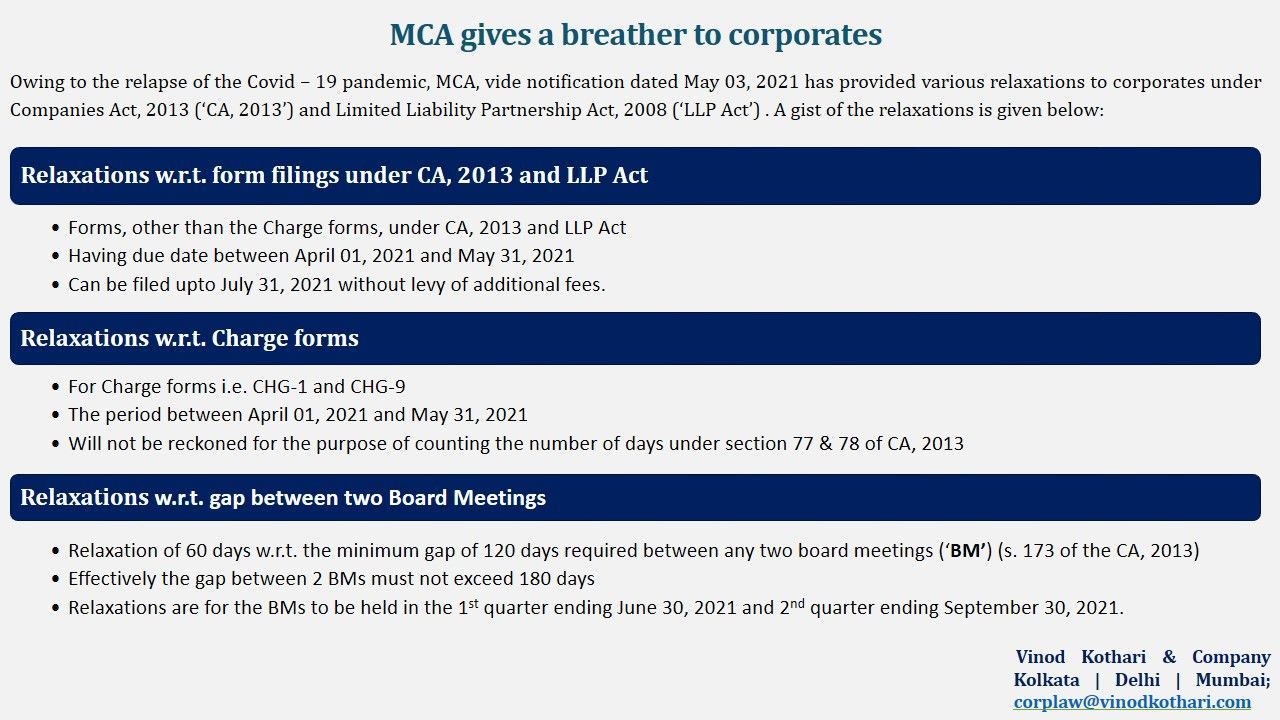Re-appointment of Independent Directors: An Analysis
Sharon Pinto, Manager, corplaw@vinodkothari.com
Introduction
Proxy advisors are entities that undertake research on corporate governance norms and practices followed across different corporates. They formulate their policies based on their research and appropriately established benchmarks. The proxy advisory firms play a role in strengthening the corporate governance as investor clients access the reports and recommendation of the said advisory firms while forming their opinions. As investors due to their vast shareholding may not be privy to the working of the company, they may rely on the analysis done by the proxy advisors and their recommendations. We have discussed the scope of guidelines issued by proxy advisors in a separate article[1].
While such reports and guidelines as mentioned above can act as a guidance for the investors to take a sound decision, the legal standing of the report can be considered a hiccup in the said process as the same does not obtain regulatory approval. We have discussed the scope and legal validity of such guidelines in a separate article.[2]
One such guideline has been issued w.r.t. re-appointment of Independent Directors under Section 149 (10) of the Companies Act, 2013 (‘the Act’). The said contention has been a question of interpretation with different practices being followed by various companies. In this article we have discussed the interpretation of the said provision while stating the process of re-appointment of Independent Directors (‘IDs’).
Pre-requisites for appointment of IDs
Section 149 (6) of the Act read with Rule 5 of the Companies (Appointment & Qualification of Director) Rules, 2014 states the criteria that shall determine the independence of the director proposed to be appointed. In case of an entity with its specified securities listed on the stock exchange, the conditions set forth by Regulation 16 (1) (b) of SEBI (Listing Obligation and Disclosure Requirements) Regulations (‘SEBI Regulations’) shall also be fulfilled in order to be eligible for appointment as an ID. The said provisions under the Act and SEBI Regulations entail certain pecuniary limits which are necessary to ascertain any monetary relationship of the director with the company, which may affect their independence. As the given criteria is a pre-requisite at the time of appointment of a director, it shall also be mandatory to be fulfilled at the time of re-appointment. Thus, if an ID continues to be eligible as per the said conditions, they shall be proposed to be re-appointed for a second term in the company.
Pursuant to the SEBI (Listing Obligation and Disclosure Requirements), 2021 (Third Amendment Regulations), the criteria of independence prescribed under Regulation 16 (1) (b) has been revised aligning the same with the provisions of the Act. However, while the Act provides for the period of 2 immediately preceding financial years for determining whether the person or his relatives have any material pecuniary relationship with the company, the revised SEBI Regulations now prescribe for a period of 3 immediately preceding financial years for determination of the same.
Further, the conditions prescribed under the Act relating to holding of any interest or security, indebtedness, any guarantee or security provided in connection to indebtedness of a third person or any other pecuniary relationship with the company or its holding or subsidiary or associate company have also been inserted in the SEBI Regulations, which provide for stricter period of compliance of the said conditions. While, the relatives may be employees in the entities stated above, they are prohibited from holding the position of a KMP. As the criteria of independence is to be observed even in the case of re-appointment, these conditions will ensure the independence of the ID.
In addition to the criteria of independence, the existing IDs of the company are required to abide by the code of conduct prescribed under Schedule IV of the Act. Any breach of the code by the directors shall make them ineligible for continuing in the position of ID of the company.
Performance Evaluation
The re-appointment of an existing director for a second term, in addition with the establishment of their independence shall also be subject to performance evaluation. The Act under Section 178 (2) states that the Nomination and Remuneration Committee (‘NRC’) of the company shall formulate a criteria for determining the qualifications, positive attributes, independence for appointment of a director. Further the committee shall also establish a criteria for the evaluation of performance of the Board as well as individual directors. Thus on the basis of such performance evaluation and establishment of independence and possession of requisite skills by the director, the NRC shall recommend the appointment or in case of an existing director, re-appointment of the said director to the Board.
SEBI[3] has detailed an elaborated process to be followed by NRC for selection of ID, including more transparent and enhanced disclosures regarding the skills required for appointment as an ID and how the proposed candidate fits into that skillset. As per the Third Amendment Regulations, the said additional disclosures stating the skills and capabilities required for the role and the manner in which the proposed person meets the requirements, will be required to be provided in the notice in the case of re-appointment of an ID. Thus, NRC of the company will be required to undertake an assessment determining whether the person proposed to be re-appointed as the ID possesses the skills required for the position in addition to performance evaluation even in the case of re-appointment.
SEBI under Regulation 17 (10) of the SEBI Regulations has stated that the performance evaluation of the IDs shall be done by the entire Board of Directors where the concerned ID shall not participate in the said discussion. The Board shall consider performance of the director in addition to fulfilment of independence criteria similar to the provisions stipulated under Companies Act, 2013 as discussed above. Thus the director proposed to be re-appointed has to satisfy the afore-mentioned dual conditions.
Process of re-appointment
Section 149 (10) of the Act has specified the process of reappointment of an ID. It states that a director shall be eligible for re-appointment by passing of a special resolution. Thus we may infer that in order to be re-appointed as an ID, a special resolution is required to be passed. Regulation 17 (11) of SEBI Regulations provides for stating recommendation of the Board for every for every special item of business in the explanatory statement annexed to the notice. As discussed above, Board on the basis of performance evaluation carried out and the recommendation of the NRC shall recommend the re-appointment of the ID. Criteria of independence being a pre-requisite for such re-appointment as established herein, the director shall be considered as an additional independent director until approval of shareholders is obtained at the general meeting of the Company.
Further, SEBI vide its consultation paper on Independent Directors[4] had proposed prior approval of shareholders for appointment and re-appointment of IDs, while stating that the existing procedure entails proposal of candidate by the NRC and appointment/re-appointment by Board which is subsequently approved by shareholders by an ordinary resolution in case of appointment whereas special resolution in case of re-appointment. Accordingly, seeking prior approval of shareholders is not a pre-requisite at present.
After end of first tenure of the ID, the office of director shall cease. Accordingly, Board will approve appointment as additional director till ensuing AGM and propose re-appointment as an ID for second term of upto 5 consecutive years.
As discussed above, re-appointment after the end of the tenure is required to be considered akin to fresh appointment of the person, thereby necessitating the confirmation with criteria of independence, assessment of skills and capabilities and the manner in which such appointee continues to meet the requirements of the company. Therefore, the Board has a power to appoint the person as an additional ID, whose appointment shall thereafter be approved at the general meeting.
Timeline for re-appointment
In order to understand the timeline in the case of re-appointment, we will have to consider the revised Regulation 17(1C) SEBI Regulations. Regulation 17 (1C) provides for approval of appointment of a person as a director of the company to be done within the next general meeting or 3 months, whichever is earlier. Since, re-appointment on account of end of term results into fresh appointment, the same shall also apply in case of re-appointment of an ID. Further, Regulation 25 (2A) has now provided for a special resolution to be obtained in case of appointment as well as re-appointment. The same prescribes for the mode of obtaining approval but is silent on the timeline, to be followed, requiring reference to Regulation 17 (1C). For a better understanding of the same, let us look at the following cases.
Case 1: Re-appointment of a person as an ID before the end of his/her tenure:
- The NRC of the company will be required to follow the due process for evaluation of the person for re-appointment as stipulated under the revised provisions and recommend the same to the Board.
- The Board will thereafter confirm on the skills and capabilities as required for the position and that the proposed appointee possesses the same and provide disclosure of the same to the shareholders in the notice for re-appointment.
- At the ensuing general meeting the company may re-appoint the person as ID for a second term by passing a special resolution with effect from the date immediately following the last day of the current tenure.
Case 2: Re-appointment of a person as an ID post the end of tenure:
- Since the tenure of the ID has been terminated, the office of the ID will stand vacated and the Board will be required to appoint the person as an Additional Director (Non-executive, ID category).
- The process as mentioned under points a & b above in relation to assessment of the candidate and requisite disclosures to be done will be required to be followed.
- As per Regulation 17(1C), shareholder approval for the re-appointment will be required to be obtained within 3 months of appointment by the Board as an additional ID or next general meeting, whichever is earlier.
Effect of re-appointment by the Board
The provisions of the Act mandate the shareholders to approve appointment of IDs at general meeting but does not mandate appointment from the date of general meeting. ‘Independent Director’ is the nature of directorship and ‘Additional Director, Non-Executive’ is the category of directorship. It cannot be inferred that the said director was not independent from the date of Board resolution appointing him as Additional Director till the date of general meeting. Therefore, the effective date of appointment can be considered from the date of Board resolution or any subsequent date prescribed by the Board.
The recent changes in the provisions as stated above will result in reducing the gap between appointment of an ID on the Board of the company and approval of the said appointment by shareholders. While it is seen that some companies take up the re-appointment of the IDs by way of postal ballot before the end of tenure in case there exists a gap between the AGM and the end of term, the same shall be construed as a good governance practice, as prior approval of shareholders has not been mandated by law on account of the same not being specifically stated. Thus in case of re-appointment post end of tenure, the same cannot be viewed as a violation of provisions.
Conclusion
The ambit of proxy advisors in India is as prescribed under SEBI regulations and guidelines issued in this regard. While they may issue guidelines based on the best governance practices as established by them and recommend the same to the investors, there is a need to incorporate a check for discerning the nature and scope of such guidelines, so the investor may have a clear view of the propositions put forth. With the process of appointment of IDs being enhanced in the manner specified above, in addition to the newly inserted disclosure requirements, will make the appointment/re-appointment process of IDs more transparent and effective while ensuring greater conformity of their independence.
Related presentation – https://vinodkothari.com/2021/08/ensuring-board-continuity-and-balance-of-capabilities/
[1] https://vinodkothari.com/2021/06/scope-of-proxy-advisors-to-issue-general-voting-guidelines/
[2] https://vinodkothari.com/2021/07/proxy-advisors-corporate-decision-making/
[3] https://www.sebi.gov.in/media/press-releases/jun-2021/sebi-board-meeting_50771.html
[4]https://www.sebi.gov.in/reports-and-statistics/reports/mar-2021/consultation-paper-on-review-of-regulatory-provisions-related-to-independent-directors_49336.html





